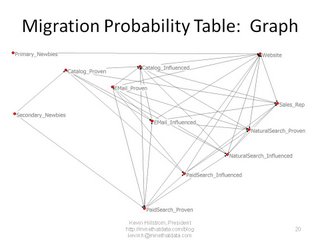Proven And Influenced Advertising Channels
 There are two types of advertising channels in the Multichannel Forensics framework.
There are two types of advertising channels in the Multichannel Forensics framework.- Proven Channels
- Influenced Channels
Oh, those were heady times.
These days, everybody is obsessed with fractionally allocating orders based on the advertising channels that they perceive to be driving orders. First touch? Last touch? Allocation across touches.
Of course, all of the allocation rules are bogus. We don't really know, do we? Especially if we don't do mail/holdout groups, and you really cannot do mail/holdout groups for paid search (though you can do some innovative spend/no-spend strategies).
So why the obsession with first touch, last touch, and fractional allocation? The end result is clouded with fiction, anyway.
There's another way to approach this challenge. Instead of investing all of our efforts on the art of allocation, why not categorize orders based on proven and influenced sources, then track how customers evolve over time --- allowing us to reduce catalog or e-mail marketing expense in the future?
Let's say that you have three advertising channels that resulted in an order:
- Catalog received on June 1.
- E-Mail received on June 3.
- Order on June 5, using Pay-Per-Click.
Here's the marketing analytics secret for you --- shhhhhh, don't tell anybody!
- When catalogs and/or e-mails move from "proven" to "influenced" advertising sources, you don't have to send as many of these to the customers using them as "influenced sources" in the future --- once customers move away from these advertising channels as their primary reason for purchasing, they become less likely to use them in the future.
This is where Multichannel Forensics, and micro-channels in particular, make a big difference.
Labels: First Touch, Fractional Allocation, Influenced Source, Last Touch, Micro-Channels, Proven Source







